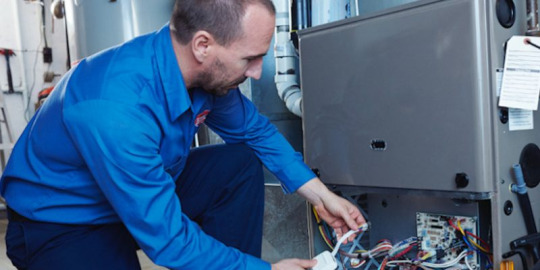Text
How to Extend the Life of Your Furnace

The last thing you want is to come home, on a cold winter night, to find your 15 year old furnace on its deathbed.
For most of us, we usually don’t pay attention to our heating and air conditioning systems until it’s too late. When your furnace inevitably breathes its last breath, you’ll be waiting for that emergency HVAC technician to arrive while you and your family are wearing jackets and toques around the house.
This is an experience nobody wants to repeat twice, and probably the reason you stopped by our blog. If you are concerned about your furnace lasting the upcoming winter, we want to equip you with the proper tools and the following 5 tips on how to extend the life of your furnace.
1. Install a programmable thermostat:
Overworking your furnace is a great way to send your furnace to heaven early. Although you’re currently toasty warm, you’re diminishing your furnace’s longevity. Without implementing balance with your furnace usage, you’ll need to start booking the funeral.
But, we’re human. Sometimes we forget to turn it down or off. So, how do you create a balance with your furnace’s usage without human error? Introducing smart and programmable thermostats.
Installing a programmable thermostat controls the usage of your heating system. Basically, it allows you to set a predefined schedule that adjusts the temperature of your home based on time of day and season, turning the heat down at night and during the day when no one is around.
Smart thermostats add an additional level of control by reacting to movement (are people home or not), creating schedules on the fly, smart control via phone apps and additional tracking to allow you much better control of your system – from anywhere in the world. Not only are they useful for furnace longevity but these new thermostats will also save you money on energy costs.
2. Replace air filter:
If your air filter looks like an old, dusty accordion, it’s past time to replace the filter. Often neglected, your air filter can drain the life out of your furnace if not replaced or cleaned. The air filter function is to clean the air and protect your system from allowing dirt and debris to enter the furnace.
When dirt begins to cover the filter, your furnace must work much harder to move air. Because dirt and dust are covering the filter, the furnace fan will need to work hard to overcome the additional resistance. Also, since less air is moving through the system, your furnace will need to run longer in order to raise the temperature. Our HVAC suggestion is to clean and check on your air filter regularly. By doing so, you’re allowing your furnace to emit warm air normally without any obstructions.
3. Prevent air leaks:
Air leaks rob you of the warm air your furnace works so hard to produce. Not only do air leaks drain your home of that warm air but it also pushes your furnace to work harder and longer, resulting in a reduction of its lifespan. Your front door, windows, walls, bathroom and kitchen vents, basement intrusions and any small gaps and spaces can allow air to infiltrate.
Preventing drafts and eliminating air leaks to ensure your home is properly sealed and insulated is one of the best things you can do to improve the comfort of your home as well as the life of your furnace.
A useful trick to determine if your door or window is causing an air leak is by lighting an incense stick and placing it in front of your inspecting area. If the smoke rises up, there’s no leak. If the smoke moves in a different direction, you have a leak. Most big box DIY stores have a whole section on weather stripping and caulking to help fill these gaps and stop leaks.
4. Perform regular maintenance:
To avoid the nightmare of getting your furnace repaired, we recommend having your furnace maintained at regular intervals. When you get your furnace tuned up, an expert HVAC technician will run through an extensive checklist of items to ensure you’re eliminating future issues that could occur on the coldest MN,USA winters.
1 note
·
View note